 |
|

|
Seaweek
Discoveries in Victoria's Marine National
Parks and Marine Sanctuaries
courtesy
Parks Victoria |
|
|
|
Port
Jackson Shark
Heterodontus portusjacksoni
Harmless, docile and gregarious in
nature, this seafloor-dwelling shark
is commonly seen nestled in groups
under rocky ledges. At night Port
Jackson sharks venture out and explore
the reef, their flattened rows of
pointed teeth and their strong jaws
enabling them to crush reef animals
such as marine snails, urchins, and
crabs. Often these sharks will regroup
in the same crevice as daylight approaches.
Each
October the females lay between 10
and 16 dark, corkscrew-shaped egg-cases
that they wedge into ledges with their
mouths. You might be lucky enough
to find one of these hatched egg-cases
on the beach.
|
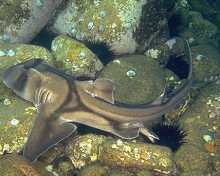 |
| |
|
 |
Spotted
Pipefish
Stigmatopora argus
Growing to 26 centimetres in length,
the Spotted Pipefish is a master of
disguise amongst seagrass, its slender
body, green colouration and slow movement
combine to provide cover to the animal
from both predator or prey. Spotted
Pipefish are ambush predators, patiently
waiting for tiny shrimp and other
microscopic animals to move a little
too close before they quickly suck
them into their tube like mouths.
The
species exhibits role reversal of
the sexes. It is the female Spotted
Pipefish who courts the male, her
colours intensifying during the breeding
season when she is competing for mates.
The selected male gets to carry the
eggs in an enclosed brood pouch on
the underside of his tail. The species
is only found in southern Australian
waters.
|
| |
|
|
Southern
Dumpling Squid
Euprymna tasmanica
A spectacular but rarely seen inhabitant
sandy areas in southern waters is
the shy, tiny, Southern Dumpling Squid.
Rotund, big eyed, and iridescent,
they are night feeders, burying themselves
in the sand during the day.
These
squid have eveloved an unusual symbiotic
relationship with light producing
bacteria. As juveniles, Southern Dumpling
Squid catch the bacteria and nurture
them inside special body cavities.
As
the squid grows, the bacteria produce
light in return for the squid providing
food (sugar). It is a mutually beneficial
relationshipbecause at night the squid
is able to control the amount of bacterial
light that it emits from its underbelly
to match the starlight or moonlight
that shimmers through the water above.
This form of camouflage is called
counter illumination and enables the
squid to avoid predators like flathead
when moving over the seagrass.
|
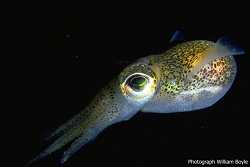 |
| |
|
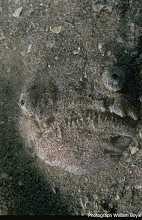 |
Common
Stargazer
Kathetostoma laeve
Although the Common Stargazer is one
of the largest fish found near reefs
on the underwater sandy plains, it
is hard to spot.
Lying almost buried, motionless, with
only its eyes and mouth peering out
of the sand, this bottom-dwelling
fish resembles a pugnacious bulldog.
With
its skilful ambush tactics, the Common
Stargazer can rapidly lunge upward,
its cavernous mouth consuming unsuspecting
fish and crustaceans in one gulp.
|
| |
|
|
Senator
Wrasse
Pictilabrus laticlavius
Inquisitive and ever active, the Senator
Wrasse is one of the most beautiful
kelp forest residents of the park
area. A carnivorous fish that hunts
a wide range of small animals including
snails, amphipods and crabs, the bright
green males and reddish females can
be seen busily slipping in and out
of the kelp fronds.
During
the spring breeding season male Senator
Wrasse become territorial and can
be seen swimming above the kelp, fins
erect. Females release millions of
eggs above the forest, and if these
are successfully fertilised by the
male, juveniles will float in the
ocean current for 2 -3 weeks. Few
survive this experience. Over 10 species
of wrasse are found in southern Australian
coastal waters.
|
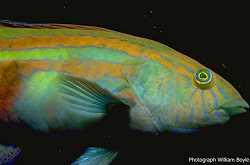 |
| |
|
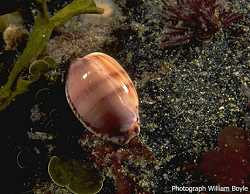 |
Cowrie
Snail
Cypraea comptoni
Beautiful, yet shy and elusive in
habit, cowrie snails can be found
on reefs in the park, feeding on sponges
living on the underside of rocks.
The snail can draw its skin-like mantle
over its distinctive shell, the colour
of the mantle assisting with camouflage.
This
is one of the smaller cowries of the
77 found in Australian waters, being
only 25 millimetres in length. It
lays its eggs in a depression in the
rocks, and then protects them until
they hatch by 'sitting' on them.
|
|
|
|
|
|
